Guides & best practices
View all articles5 Best Jotform alternatives for paid ads (2025 guide)

When you’re running paid ads, every click costs money and every drop-off hurts ROI. Jotform works fine for collecting basic form data, but it isn’t designed to convert website visitors from your campaigns into qualified leads.
You need a funnel builder built to drive conversions and track paid ad performance.
In this guide, we compare five of the best Jotform alternatives for paid marketers, tools that let you create custom forms, run A/B tests, track user responses, and even accept payments directly from ads. Each platform in this list was evaluated based on its key features, pros and cons, and real user reviews from pay-per-click (PPC) specialists, growth marketers, and demand generation teams who use them every day.
5 Jotform alternatives for paid ad campaigns: Comparison overview
#1. Heyflow | #2. Typeform | #3. Unbounce | #4. Formstack | #5. Formidable Forms | |
Landing page blocks | ✅ | ❌ | ✅ | ❌ | ❌ |
Custom branding and design | ✅ | ❌ | ✅ | ✅ | ✅ |
Built-in lead validation | ✅ | ❌ | ❌ | ❌ | ❌ |
Custom code | ✅ | ✅ | ✅ | ❌ | ✅ |
Integrations | ✅ | 🟧 | ✅ | ✅ | ✅ |
Built-in analytics & A/B testing | ✅ | ❌ | ✅ | ✅/❌ | ❌ |
Pricing (starting from) | $45/mo | $29/mo | $99/mo | $99/mo | $39.50/yr |
#1. Heyflow
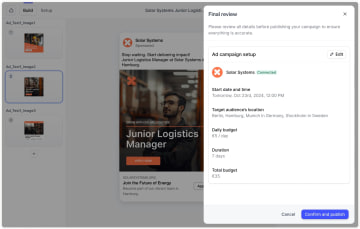
Heyflow is built for performance marketers running paid campaigns. Its no-code builder creates mobile-first, interactive lead generation funnels that act as landing pages and forms in one, turning ad clicks into qualified leads.
Heyflow combines funnel design, analytics, drop-off tracking, and built-in A/B testing to help teams continuously optimize ROAS.
Heyflow also integrates natively with Meta, Google, LinkedIn, and TikTok pixels, including server-side APIs like Meta CAPI and TikTok Conversions API for accurate attribution. You can split-test creatives, analyze friction points, and forward conversions directly to ad platforms for smarter optimization loops.
Best for performance marketers and growth teams
Heyflow is best lead generation software for performance-driven marketers and growth teams who want to turn paid clicks into qualified leads. It’s ideal for SMBs or enterprises running multi-step paid campaigns across Meta, Google, LinkedIn, or TikTok.
Choose Heyflow if you want to:
Build interactive, mobile-first funnels that convert targeted ad traffic
Track, test, and optimize every step without extra tools
Keep attribution clean with native ad platform integrations
Key features
Category | Availability | Features |
Landing page content blocks | ✅ | Pre-built, mobile-optimized blocks let you build full landing experiences that keep ad clicks engaged through visuals, CTAs, and microinteractions. |
Custom branding and design | ✅ | Full design control to match brand guidelines without code. Templates, fonts, and media customization keep ad funnels on-brand and conversion-focused. |
Built-in lead validation | ✅ | Native phone and OTP checks help filter fake or duplicate leads before they reach your CRM, improving lead quality and campaign ROI. |
Custom code | ✅ | Supports embedded scripts, pixels, and advanced tracking logic. Ideal for performance marketers who use Meta CAPI, TikTok API, or custom event tracking. |
Integrations | ✅ | 100+ Native and API integrations, including ad platforms (Meta, Google, TikTok, LinkedIn), CRMs, and webhooks for seamless lead routing and attribution. |
Built-in analytics and A/B testing | ✅ | Includes drop-off analytics, traffic-split testing, and conversion dashboards to identify bottlenecks and improve ROAS directly inside the platform. |
Heyflow strengths and limitations
Pros | Cons |
Conversion-driven by design with 40+ drag-and-drop blocks, advanced logic, calculators, payments, bookings, and signatures | Collaboration features are only available on the Enterprise plan |
Full brand control with 1,000+ fonts with the option to upload custom fonts, 2,000+ style variables, and support for custom CSS, JS, and HTML | A/B testing is available only in the Scale plan |
Enterprise-grade security with SOC 2, ISO 27001, and HIPAA compliance, plus TrustedForm and Jornaya lead validation | No free plan |
Built-in analytics, including funnel metrics, drop-off insights, and performance dashboards | |
Deep integrations with GA4, Meta CAPI, Google Ads, LinkedIn, Salesforce, and HubSpot |
Pricing
Starter: $45 per month with essential features for small businesses starting out
Growth: $119 per month is the most popular plan, with design and conversion tools to optimize and qualify leads
Scale: $289 per month offers a complete toolkit for scaling teams with advanced integrations and testing
Enterprise: Custom quote for tailored workflows, higher quotas, and dedicated support
User reviews
Users appreciate how Heyflow helps them drive more conversions from paid traffic, without the complexity of juggling multiple tools.
“The main thing we wanted to get out of Heyflow was better conversion rates for our clients. With cost per lead rising all the time, the key for us was achieving a lower CPL and higher conversion rates. Heyflow solved both challenges very quickly.”
— Sam Obrart, Founder, Atomic Marketing
#2. Typeform
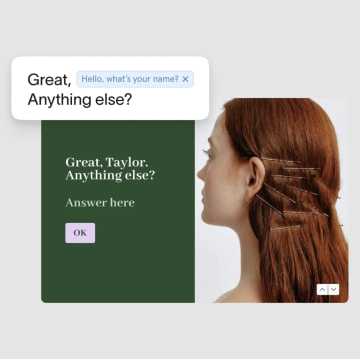
Typeform supports paid ad funnels by turning online forms and quizzes into high-performing ad destinations. Its drag-and-drop interface lets marketers create custom, multi-page forms that capture leads and segment audiences. Through Google Tag Manager and Facebook Pixel, lead generation campaigns can track form performance, measure conversions, and build retargeting audiences.
The Clever Ads integration promotes forms directly through Google Display Ads. While Typeform offers a polished form builder with conditional logic and data collection features, A/B testing and advanced analytics require third-party tools.
Best for interactive online forms and quizzes for lead generation
Typeform is best for marketers running low- to mid-budget paid campaigns who want visually engaging online forms or quizzes to collect leads and feedback without a heavy setup.
Choose Typeform if you:
Run lead generation or survey-style ads and want a clean, conversational form experience
Need a simple form builder with conditional logic and drag-and-drop editing that integrates easily with ad tracking pixels
Want a free plan to test basic form performance before scaling to paid tiers
If you manage high ad spend or multi-step funnels, other alternatives like Heyflow offer far greater design flexibility and conversion control. With Heyflow, you can build fully custom, on-brand interactive forms and landing pages, unlike Typeform, which tends to look the same across campaigns. You’ll also get deeper analytics, A/B testing, and optimization tools to continuously improve funnel performance.
Key features
Category | Availability | Features |
Landing page content blocks | ❌ | Typeform doesn’t offer a traditional landing page builder with modular “blocks” |
Custom branding and design | ✅ | Include themes, brand kits, custom colors, fonts, backgrounds, logos, and media to align form destinations with brand guidelines for paid traffic. However, it only lets you put one question per page/screen |
Built-in lead validation | ❌ | Doesn’t offer native lead validation tools like email/phone verification or OTP as a built-in feature. Validation relies on form logic and external integrations rather than a dedicated verification system. |
Custom code | ✅ | Allows adding tracking via official Facebook Pixel integration and Google Tag Manager, enabling custom tags and scripts for paid attribution and retargeting |
Integrations | ❌ | There is no official server-side tracking or native Meta Conversions API integration. CAPI setups discussed in community threads rely on external servers or third-party tools. No integrations for Taboola or Outbrain either. Connections seen online are from third-party tracking platforms and are not first-party Typeform integrations |
Built-in analytics and A/B testing | ❌ | Doesn’t have native A/B testing for forms. Experimentation typically requires third-party tools or parallel form variants with external traffic splitting. |
Typeform strengths and limitations
Pros | Cons |
Useful conditional logic (Logic Jumps) for creating personalized, multi-page forms | Limited customization and branding flexibility compared to other form builders. ‘It feels like a Typeform.’ |
Fast setup and AI-assisted form creation for campaign deployment | Free plan has strict response limits and fewer features |
Reliable data collection and export to CRMs and analytics tools | Lacks offline functionality and can feel slow for long or complex forms |
Pricing
Core Plans
Basic: $29 per month with essential features to create interactive forms and connect them to your workflow
Plus: $59 per month to make your forms more beautiful and on-brand, with a custom subdomain and no Typeform branding
Business: $99 per month to analyze performance, track conversions, and get priority support for larger teams
Enterprise: Custom quote
Growth Plans
Growth Essentials: $199 per month for small teams looking to generate and engage leads with AI and video questions
Growth Pro: $349 per month for growing teams that need automation, multi-language forms, and marketing integrations
Growth Custom: Custom quote
Talent Plans
Talent: $149 per month to enhance employee experiences with AI, video, and multilingual features
Enterprise: Custom quote
User reviews
Users appreciate Typeform’s ease of use for creating engaging online forms and quizzes. As Neha J., UX/UI Designer, says, “It’s an all-in-one tool to collect info through surveys and feedback. Conditional logic and the easy-to-use interface make it a frequent choice for research.”
However, some users note that accessing all features can get expensive. Feraud O., a small business owner, shared, “The way the forms can be made to look and the conditional logic flow are brilliant, but the cost is pretty high if you want all the features.”
#3. Unbounce
Unbounce is built for performance marketers running PPC and paid social campaigns who need dedicated, high-converting landing pages with best practices. Its drag-and-drop builder lets you design custom, on-brand pages without coding, helping teams capture leads and optimize conversion performance across campaigns. The platform supports conditional logic and dynamic content, plus custom domains for delivering message-matched, branded experiences that align seamlessly with your ads.
With A/B testing, Smart Traffic, and seamless data collection integrations, Unbounce enables marketers to optimize conversions, reduce cost-per-click, and scale B2B lead generation through focused, conversion-driven ad workflows.
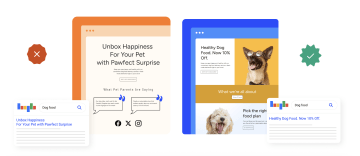
Unbounce is built for performance marketers running PPC and paid social campaigns who need dedicated, high-converting landing pages with best practices. Its drag-and-drop builder lets you design custom, on-brand pages without coding, helping teams capture leads and optimize conversion performance across campaigns. The platform supports conditional logic and dynamic content, plus custom domains for delivering message-matched, branded experiences that align seamlessly with your ads.
With A/B testing, Smart Traffic, and seamless data collection integrations, Unbounce enables marketers to optimize conversions, reduce cost-per-click, and scale B2B lead generation through focused, conversion-driven ad workflows.
Best for marketing teams with PPC budgets that need A/B testing and conversion optimization tools
Unbounce is best for performance marketers and PPC specialists who want control over post-click experiences.
Choose Unbounce if you:
Run high-intent paid campaigns and want to test landing page variations to boost conversion rates
Need a drag and drop editor with custom domains, A/B testing, and Smart Traffic optimization
Care about form performance, data collection, and delivering on-brand experiences without extra tools or coding knowledge
If you’re after simple online form builders, Typeform or Jotform are better fits, but for conversion-driven ad funnels, Heyflow is a better alternative.
Key features
Category | Availability | Features |
Landing page content blocks | ✅ | Drag-and-drop landing page builder with modular blocks to create message-matched pages for each PPC ad group or offer |
Custom branding and design | ✅ | Full visual control with templates, color schemes, and styling tools to match ad creatives and maintain brand consistency |
Built-in lead validation | ❌ | No native lead verification (like OTP or email checks); relies on integrations or third-party tools for validation |
Custom code | ✅ | Supports adding tracking pixels, scripts, and custom code for advanced paid campaign attribution and event tracking |
Integrations | ✅ | Connects with Google Ads, Google Analytics, Meta Pixel, and Google Tag Manager for ad tracking. Plus Salesforce, Marketo, Mailchimp, Klaviyo, AWeber, and Zapier for lead routing and automation. Supports script deployment via Script Manager and webhooks for full PPC-to-CRM data flow |
Built-in analytics and A/B testing | ✅ | Offers native A/B testing and AI-driven Smart Traffic to automatically optimize landing pages for better conversion rates |
Unbounce strengths and limitations
Pros | Cons |
Easy drag-and-drop builder for fast landing page creation | Very expensive, with steep price increases and new usage caps |
Built-in A/B testing, Smart Traffic, and dynamic text replacement for better conversions | Limited built-in analytics and behavior insights |
Helps teams quickly launch message-matched pages for PPC campaigns | Occasional editor bugs and template limitations |
Pricing
Build: $99 per month for small teams that want to create unlimited landing pages quickly with an easy drag-and-drop builder
Experiment: $149 per month for marketers who want to run unlimited A/B tests and fine-tune conversion performance
Optimize: $249 per month for growing teams that need AI-powered Smart Traffic, advanced targeting, and performance insights.
Agency: Custom quote
User reviews
Users appreciate how easy Unbounce makes it to build and launch high-converting landing pages. Michael D., Director of Marketing, shared, “The intuitive drag-and-drop builder lets you create beautiful, conversion-optimized pages without any coding knowledge. It’s fast, flexible, and integrates with all the major marketing tools.”
However, not everyone is happy with the pricing changes. Dennis S., Co-Founder, noted, “Our subscription increased by more than 400% in under a year with no new features to justify it. It’s unfortunate to see a great product become so focused on profit over value.”
#4. Formstack
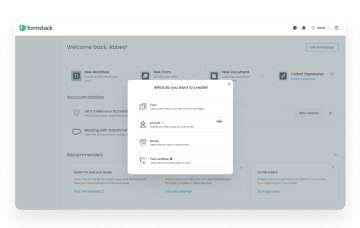
Formstack is an intuitive form builder that turns paid ad clicks into qualified leads. Its drag and drop editor and dynamic forms make it easy to design multi-page forms, contact forms, and order forms without coding knowledge. The platform supports conditional logic, partial submissions, and form data analytics to improve form performance and recover lost conversions.
Built-in UTM tracking and integrations help teams to seamlessly integrate with CRMs, route form responses, and manage data collection at scale. With custom domains, advanced functionality, and HIPAA compliance, Formstack is among the best Jotform alternatives for paid marketers who want business tools that optimize lead generation and automate data management across workflows.
Best for teams running paid campaigns that need automated data collection and lead routing
Formstack is best for marketing and sales teams that want to capture, analyze, and automate lead data from paid campaigns without needing technical skills.
Choose Formstack if you:
Run multi page forms or complex forms that need conditional logic and automated data collection
Want to recover lost leads with partial submissions and improve form performance through conversion analytics
Need to seamlessly integrate ad leads into CRMs, ERPs, or other business tools for faster follow-up
If you only need basic online form builders for simple surveys or contact forms, lighter tools like Typeform or Zoho Forms will do the job.
Formstack key features
Category | Availability | Features |
Landing page content blocks | ❌ | No modular landing page builders or block-based layouts for PPC pages |
Custom branding and design | ✅ | Allows marketers to build branded, on-brand capture forms and workflows using no-code or AI builders for paid campaigns |
Built-in lead validation | ❌ | Does not include native lead verification such as email or phone validation; relies on automation or external tools for data accuracy |
Custom code | ❌ | Custom coding is not documented on referenced pages; features are managed through integrations and workflow settings |
Integrations | ✅ | Connects to hundreds of tools, including CRMs, ERPs, and analytics apps. Supports Google Analytics and UTM Tracking for ad attribution and lead routing |
Built-in analytics and A/B testing | ✅/❌ | Offers UTM tracking, Partial Submissions, and Field Bottlenecks for conversion analytics but no native A/B testing |
Formstack strengths and limitations
Pros | Cons |
Easy to use with a simple, intuitive interface that doesn’t require coding knowledge | Expensive for smaller teams or organizations, especially when scaling to advanced features |
Reliable data collection and compliance features, including HIPAA support for sensitive information | Limited design flexibility — forms can look plain without CSS customization |
Great for automating tasks like contracts, proposals, and lead routing | Some users report difficulties with billing transparency and contract cancellations |
Pricing
Forms: $99 per month for teams collecting data with a no-code, drag-and-drop builder
Suite: $299 per month for businesses that want Forms, Documents, and Sign in one plan.
Enterprise: Custom quote
User reviews
Users appreciate how Formstack simplifies form creation and workflow automation. Audrey C., Planning and Design Engineer, shared, “Formstack handles complex forms, integrates smoothly with other programs, and ensures compliance for sensitive data.”
However, not everyone finds it perfect for their budget. Michael M., Director of Digital Marketing, noted, “It’s not very user-friendly and feels overpriced for what it offers.”
#5. Formidable Forms
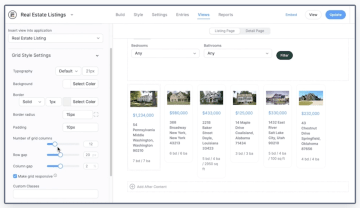
Formidable Forms is a WordPress form-building tool that helps marketers create custom forms for post-click capture and lead generation. It’s an intuitive form builder with a drag-and-drop editor that enables users to build multi-page forms, order forms, and payment forms. Teams can track form performance, capture UTM data, and analyze form responses through Google Tag Manager or analytics scripts.
With conditional logic, dynamic forms, and custom domains via WordPress hosting, it supports personalized ad experiences and better data collection. Integrations with CRMs, email platforms, and payment processing tools like Stripe or PayPal make it one of the best Jotform alternatives for advertisers seeking advanced functionality and seamless business workflows in their paid plans.
Best for WordPress marketers building conversion-ready forms
Formidable Forms is best for marketers and WordPress users who want to create professional forms directly on their websites to capture leads from paid ads.
Choose Formidable if you:
Need an intuitive form builder with a drag and drop interface to create custom forms, multi-page forms, or complex forms with conditional logic
Want a form-building tool that supports payment collection, online payments, and order forms through Stripe or PayPal
Use WordPress and want custom domains, advanced functionality, and native embedding for tracking form performance
If you just need basic online form builders or a free Jotform alternative, simpler tools like Zoho Forms or Google Forms are easier to start with.
Formidable Forms key features
Category | Availability | Features |
Landing page content blocks | ❌ | Focused on WordPress form embedding rather than standalone landing pages or modular block layouts |
Custom branding and design | ✅ | Inherits WordPress theme styling with layout controls, HTML blocks, and customization options for branded capture forms |
Built-in lead validation | ❌ | Offers spam protection via Google reCAPTCHA, hCaptcha, and Cloudflare Turnstile, but lacks native OTP, phone, or email validation |
Custom code | ✅ | Supports HTML blocks and custom scripts to add pixels, JavaScript, and tracking tags for paid ad attribution |
Integrations | ✅ | Connects with Mailchimp, HubSpot, Salesforce, ActiveCampaign, and Zapier for lead routing; also supports Stripe, PayPal, and Authorize.net for payments |
Built-in analytics and A/B testing | ❌ | Enables tracking through Google Tag Manager and Analytics but lacks built-in dashboards or A/B testing tools |
Formidable Forms strengths and limitations
Pros | Cons |
Handles complex forms with conditional logic, calculations, and 100+ form fields smoothly | Can get expensive for small websites or single-use projects |
Works seamlessly on WordPress and doesn’t conflict with other plugins | Limited styling options without CSS customization |
Great value for building professional forms and automating data collection | Form statistics and view notifications can be distracting by default |
Pricing
Basic: $39.50 per year for simple form building needs with essential features to create forms that convert
Plus: $99.50 per year for freelancers who want dynamic forms, data displays, and integrations with tools like Mailchimp and AWeber
Business: $199.50 per year for teams managing multi page forms, payment forms, and conversational forms with conditional logic and digital signatures
Elite: $299.50 per year for businesses needing advanced functionality, AI form generator, CRM integrations (Salesforce, HubSpot), and unlimited sites
User reviews
Users love Formidable Forms for its flexibility and ease of use within WordPress. Alfonso I., Director of Marketing, said, “Calling it a contact form is an understatement. You can create dynamic, complex forms with endless customization; it’s not just a form builder, it’s a content creator.”
However, some users mention that pricing can be steep for smaller projects. Salvatore C., Developer, shared, “It’s easy to install and use, and the integrations are great, but some versions are too expensive for small sites. I wish they offered a lower-cost option.”
Why switch to a Jotform alternative when running paid campaigns?
Running paid ads is one thing; converting that traffic is another. Jotform works well for simple data capture, but it falls short when you need:
Full landing pages that warm up ad traffic
Analytics that show where users drop off
Reliable UTM tracking and attribution
Built-in lead verification
Pricing that scales with your campaigns
Let’s take look at each of these in detail below.
1. You can’t build full landing pages that convert ad traffic with Jotform
Jotform works well for simple data capture, but it isn’t designed to host full landing experiences. Paid campaigns need storytelling, visuals, and flexible content blocks that build trust, urgency, and can adapt on the fly without needing to rope in your design team. Without these, you’re sending cold traffic straight into a dull form with no warm-up, leading to lower conversion rates.
One Jotform user shared, “It’s a really helpful tool to design forms and take input and feedback from users... but, the overall look and feel of the platform can be improved.” (Ayush A., G2).
That “look and feel” gap matters, especially when your ad clicks cost real money and the page has to sell to make up for the spend.
2. You don’t get analytics that show where paid users drop off
When you’re optimizing ad funnels, knowing where people leave matters more than how many do. Jotform doesn’t provide page-by-page or field-level drop-off analytics, so you can’t see whether users bounce at the intro step, pricing question, or contact field.
Without those insights, improving ROAS becomes a matter of guesswork.
Another Jotform user, Dustin M, puts it well: “Jotform’s limitations become more apparent as your reliance on the platform grows.” Limitation shows up quickly when every minor tweak—like button copy, field order, or image placement—could make or break your cost per acquisition.
3. Tracking and attribution are fragile without a developer’s help
UTMs don’t automatically flow through your forms. You have to manually append parameters, capture them through hidden fields, and pray they survive redirects. If a visitor clicks through multiple steps, or an embedded form drops the query string, your campaign data is gone. For agencies managing multiple ad sets, this means messy attribution and unreliable performance reports.
One marketer shared, integrations were “a big niggly” on Jotform (Alathea L., G2), a small but constant pain when you’re trying to link every click, form fill, and conversion back to its source. In paid ads, clean data is what drives scaling decisions and keeps winning your budget for the next quarter.
4. Lead verification and load performance can tank ROI
Even if users do fill out the form, Jotform doesn’t offer native lead verification. You’ll need to connect a Twilio account for SMS OTPs, adding extra cost and complexity. This makes it harder to ensure paid leads are real, which directly affects campaign efficiency.
On top of that, forms embedded on websites can load slowly, a problem one reviewer noted as “minor formatting issues depending on device and browser” (Dixit K., G2).
And in paid campaigns, every second costs you conversions. Improving page load speed and Largest Contentful Paint (LCP) directly reduces bounce rates and increases the percentage of users who complete an action. A delay of even a few seconds can move a landing page from “good” to “needs improvement,” hurting both user experience and ad ROI.
5. Pricing scales up before your campaigns can
Jotform’s free plan caps form submissions at 100 per month — fine for internal use, but unsustainable for paid campaigns. Once you hit limits, you’re forced to upgrade to higher tiers without getting advanced marketing capabilities like testing, analytics, or custom domains.
As one reviewer, Jessa W., put it, “The free plan is way too limited... you’re forced to upgrade”. Another user, Tom G., noted, “The cost can rise steeply if you require higher submission limits or need access to advanced features”. You end up paying more for volume, not for value, and that’s a tough sell for performance teams running cost-sensitive ad funnels.
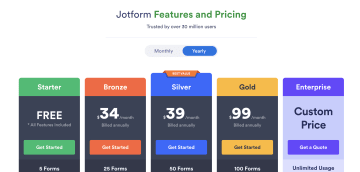
Ready to turn every ad click into a lead? Start with Heyflow
The right form builder really depends on what your campaigns need most.
If you want a free Jotform alternative to create simple online forms, tools like Typeform are great starting points for quick data collection and basic lead capture.
For teams that prefer multi page forms with conditional logic, Formidable Forms offers more advanced flexibility inside WordPress.
Unbounce fits best if your team manages multiple ad campaigns and wants to test landing pages, order forms, and on-page form performance with precision.
But, if your goal is to create custom forms that turn paid clicks into qualified leads with conversion insights, Heyflow is a great choice. It brings everything paid marketers need into one place, dynamic forms, drag-and-drop editing, payment processing, real-time tracking, and built-in analytics.
Your next high-performing campaign could be just one flow away.
Jotform alternative FAQs
Q1. Why isn’t Jotform ideal for paid ad campaigns?
Jotform is great for online forms and everyday data collection, but it isn’t built for optimizing form performance in paid ads. It lacks built-in testing, advanced functionality, and tracking tools that show how website visitors interact with each step. Without insights into drop-offs or user responses, you’re left guessing which part of your funnel loses conversions. For marketers spending on traffic, that makes every click more expensive.
Q2. What should I look for in a Jotform alternative for paid ads?
Look for an intuitive form builder with branching logic, email notifications, and the ability to accept payments directly from your contact forms or conversational forms. A Jotform alternative should support team collaboration, allow unlimited form views, and come with analytics to measure form performance. Choose tools that reduce the learning curve and include features like version history, so you can test and improve quickly without losing data.
Q3. Which Jotform alternative works best for performance marketers?
For teams focused on ROAS and payment submissions, Heyflow is the top choice. It combines advanced functionality, dynamic forms, and built-in optimization to convert ad clicks into leads or sales. You can easily track user responses, add conditional paths with branching logic, and manage payment collection, all without coding. Heyflow offers an unlimited number of funnels, giving performance marketers full control over campaign testing and scaling.
Q4. Is Typeform a good alternative to Jotform for ads?
Yes, if you want visually great forms and an enjoyable conversational form experience. Typeform is ideal for engaging website visitors with surveys or quizzes that match your brand’s background image and style. However, it’s more design-focused than performance-focused. For teams needing deeper analytics, payment processing, and full-funnel visibility, Heyflow is the go-to form builder for serious advertisers running high-intent paid campaigns.


